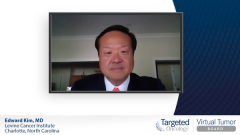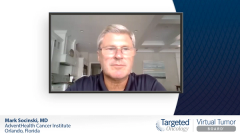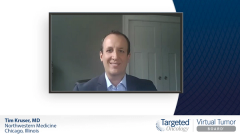
Case 2: EGFR-Positive Non–Small Cell Lung Cancer
Episodes in this series

Mark Socinski, MD: I haven’t actually been in the situation where a patient has come to me for an opinion already on immunotherapy and subsequently was found to have an EGFR mutation. I don’t know if that’s happened in your practice.
Edward Kim, MD: Fortunately, it’s more of the situation we discussed where someone started chemotherapy or even I/O and they haven’t been tested yet. We have found actually some other alterations molecularly, but luckily not EGFR mutations.
Mark Socinski, MD: I did have a discussion earlier this week with one of our colleagues who had actually 2 cases that she was struggling with regard to this thing. Patient was on pembrolizumab, they subsequently found an EGFR mutation, and she was struggling with what to do and how to do it and was having some issues with that. I hope this is going away, but how often do you get insufficient reports in your practice?
Edward Kim, MD: It’s rare now. We do a check to make sure. The worst is when you’ve already sent it and you get the QNS back, and that just wasted 2 weeks of everyone’s time. I think more practices are being diligent about looking at the amount of tumor that’s within the specimen, so that it’s adequate. I think it’s happening less and less.
Mark Socinski, MD: I would agree with that. I had my first patient in a while this week. I don’t want to offend anybody, but one of the most useless diagnostic procedures, in my opinion, often in the work-up of patients with lung cancer is a bronchoscopy. I had one this week that had the diagnosis of adenocarcinoma but QNS to do either PD-L1 or molecular testing. I saw the patient, it was interesting. He said, “What do you think this bump on my head is?” and on MRI it looks like a classic subcutaneous metastasis, and so we’re going to biopsy that. We had accessible tissue there, but we’ve got to make sure that we’re getting things up front efficiently for this population. How often do you have to do a second biopsy? I assume if you’re not getting much QNS, you’re getting stuff up front?
Edward Kim, MD: Yes. We rarely get second biopsies. I think many of us would think about, if we have a diagnosis, then we would think about doing liquid. If we didn’t have a diagnosis, then another repeat biopsy would be done, and I’d have to scold one of my interventional folks.
Mark Socinski, MD: I think it’s important to let the audience know that we throw this term around, EGFR mutation, and what we’re mostly talking about are the exon 19 deletions and the exon 20 L858R, but there are others, and I think it’s important to realize that some of these are not sensitivity mutations. The biggest suspect there is the exon 20 insertions, which we really don’t have a good drug yet, at least not an FDA-approved drug at this point. It’s important to realize that all EGFR mutations are not created equal, and we do have some uncommon mutations in which you may think about a different drug in this setting.
So this patient has a molecular testing panel, and importantly she is found to have an EGFR exon 19 deletion mutation, but we don’t know the time course. So here we have exon 19 deletion in the setting of a high PD-L1 expression. What are your thoughts in terms of therapeutic options for this patient, Ed?
Edward Kim, MD: These days, it’s osimertinib. Get it started. Hopefully there’s not an issue with getting the drug or copay, it’s less of that these days, and get them started.
Mark Socinski, MD: When osimertinib was trying to break out of the second-line T790M space, there seemed to be an appetite for this issue of sequencing—give a first-generation or second-generation drug first, and then when T790M rears its ugly head, use osimertinib at that time. There were all these arguments about PFS1, PFS2, would that get you further than using osimertinib up front? I don’t think we’re having that argument anymore.
Edward Kim, MD: Yes, I’m glad. Although baseball is limited right now, the starting pitchers, you use them as your starters on the frontline, and when they are not being so effective, you move them to the bullpen. Eckersley is a classic example of that, you don’t want to put your best pitchers in the bullpen. You want to put good pitchers because they have to finish strong, but you’ve got to start off as best as you can.
Mark Socinski, MD: What are your thoughts, we had a recent approval of an anti-VEGF drug in this space with erlotinib/ramucirumab based on the RELAY data. We’ll talk about the FLAURA data in a moment, but has that changed your view at all?
Edward Kim, MD: As you know, there were some inklings of these data and other combinations that had come out about a year ago at some national trials. I never understood, again, that concept of adding an extra drug to get a similar result. There are adverse effects that occur with these drugs. Ramucirumab is much better than bevacizumab, but I don’t know how that helps the patient, especially taking an oral drug, without an IV, that has great effectiveness, has great CNS effectiveness, a great adverse effect profile. It never made a lot of sense to me, but kudos for people doing research and finding a benefit there.
Mark Socinski, MD: Yes. Even though we know the EGFR mutated disease is a very VEGF-driven disease, I like the description that Jared Weiss from the University of North Carolina School of Medicine always says: it really medicalizes your treatment. You’re coming for an infusion every 2, 3 weeks, whatever the schedule is, and it doesn’t necessarily get you any further mileage from the data that we have in the absence of a head-to-head trial.
Transcript edited for clarity.












































